

CEB Shifts to Shape a Learning Culture. CEB Building a Productive Learning Culture. 5 Strategies For Big-Picture Thinking. I once had a conversation with a product manager who asked me an important question: “How do I make sure I’m thinking about the big picture, when I’m always working on a lot of small things that seem to take up all my time?”
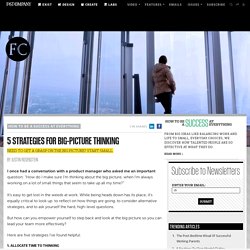
It’s easy to get lost in the weeds at work. While being heads down has its place, it’s equally critical to look up: to reflect on how things are going, to consider alternative strategies, and to ask yourself the hard, high-level questions. But how can you empower yourself to step back and look at the big picture so you can lead your team more effectively? Here are five strategies I’ve found helpful: 1. This might sound obvious, but it’s amazing how infrequently we actually do this. Block off time on your calendar based on when you’re most creative (morning, afternoon, evening). 2. Once you’ve allocated time to thinking, you’ll likely come upon a stumbling block: it’s hard to sit down and say to yourself, “Okay . . . think!” 3. 4. 5. Growth Mindset, by Carol Dweck, Ph.D. Research on the growth mindset shows that students who believe they can grow their basic abilities have greater motivation and higher achievement than do students who believe their abilities are fixed, and that teachers can influence students’ mindsets.
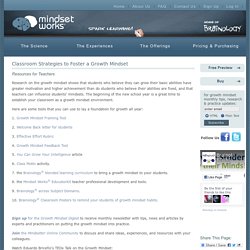
The beginning of the new school year is a great time to establish your classroom as a growth mindset environment. Here are some tools that you can use to lay a foundation for growth all year: 1. Growth Mindset Framing Tool 2. 3. 4. What Are Learning Organizations, and What Do They Really Do? Dr.
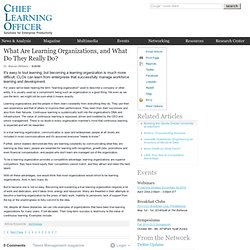
Warren Wilhelm - 9/26/06 It's easy to tout learning, but becoming a learning organization is much more difficult. CLOs can learn from enterprises that successfully manage workforce learning and development. For years we've been hearing the term "learning organization" used to describe a company or other entity. It is usually used as a compliment: being such an organization is a good thing. Building a Learning Organization. The Idea in Brief As we all know, to stay ahead of competitors, companies must constantly enhance the way they do business.
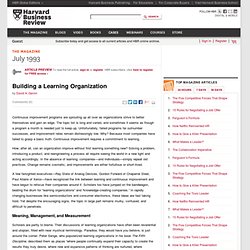
But more performance-improvement programs fail than succeed. That’s because many managers don’t realize that sustainable improvement requires a commitment to learning. After all, how can organizations respond creatively to new challenges (shifts in customer preferences, market downturns) without first discovering something new—then altering the way they operate to reflect new insights? Without learning, companies repeat old practices, make cosmetic changes, and produce short-lived improvements. Senge: theory and practice of the learning organization.
Contents: introduction · peter senge · the learning organization · systems thinking – the cornerstone of the learning organization · the core disciplines · leading the learning organization · issues and problems · conclusion · further reading and references · links Peter M.
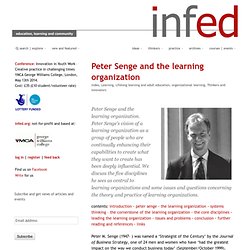
Senge (1947- ) was named a ‘Strategist of the Century’ by the Journal of Business Strategy, one of 24 men and women who have ‘had the greatest impact on the way we conduct business today’ (September/October 1999). While he has studied how firms and organizations develop adaptive capabilities for many years at MIT (Massachusetts Institute of Technology), it was Peter Senge’s 1990 book The Fifth Discipline that brought him firmly into the limelight and popularized the concept of the ‘learning organization’.
Since its publication, more than a million copies have been sold and in 1997, Harvard Business Review identified it as one of the seminal management books of the past 75 years. Peter Senge The core disciplines. Make Learning Matter: Become a Learning Organization. Organizations with the best chance to succeed and thrive in the future are learning organizations.
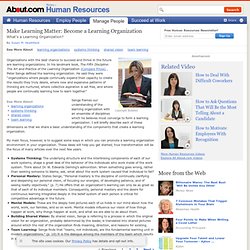
In his landmark book, The Fifth Discipline: The Art and Practice of the Learning Organization (Compare Prices) , Peter Senge defined the learning organization. State of corporate learning and development. Whatever we might like to think, our corporations are not isolated from the surrounding society.
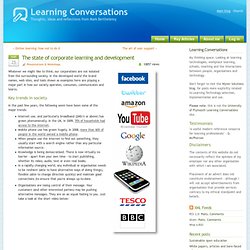
In the developed world the brand names, web sites, and tools shown as examples here are playing a major part in how our society operates, consumes, communicates and learns. Key trends in society In the past few years, the following seem have been some of the major trends: Internet use, and particularly broadband (2Mb/s or above) has grown phenomenally. In the UK, in 2009, 70% of households had access to the internet.
Key trends in learning. Dan Pink: How Teachers Can Sell Love of Learning to Students. By Jennie Rose In his new book To Sell is Human, author Daniel Pink reports that education is one of the fastest growing job categories in the country.
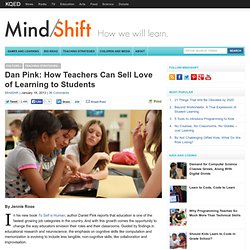
And with this growth comes the opportunity to change the way educators envision their roles and their classrooms. Guided by findings in educational research and neuroscience, the emphasis on cognitive skills like computation and memorization is evolving to include less tangible, non-cognitive skills, like collaboration and improvisation. Jobs in education, Pink said in a recent interview, are all about moving other people, changing their behavior, like getting kids to pay attention in class; getting teens to understand they need to look at their future and to therefore study harder.
At the center of all this persuasion is selling: educators are sellers of ideas.